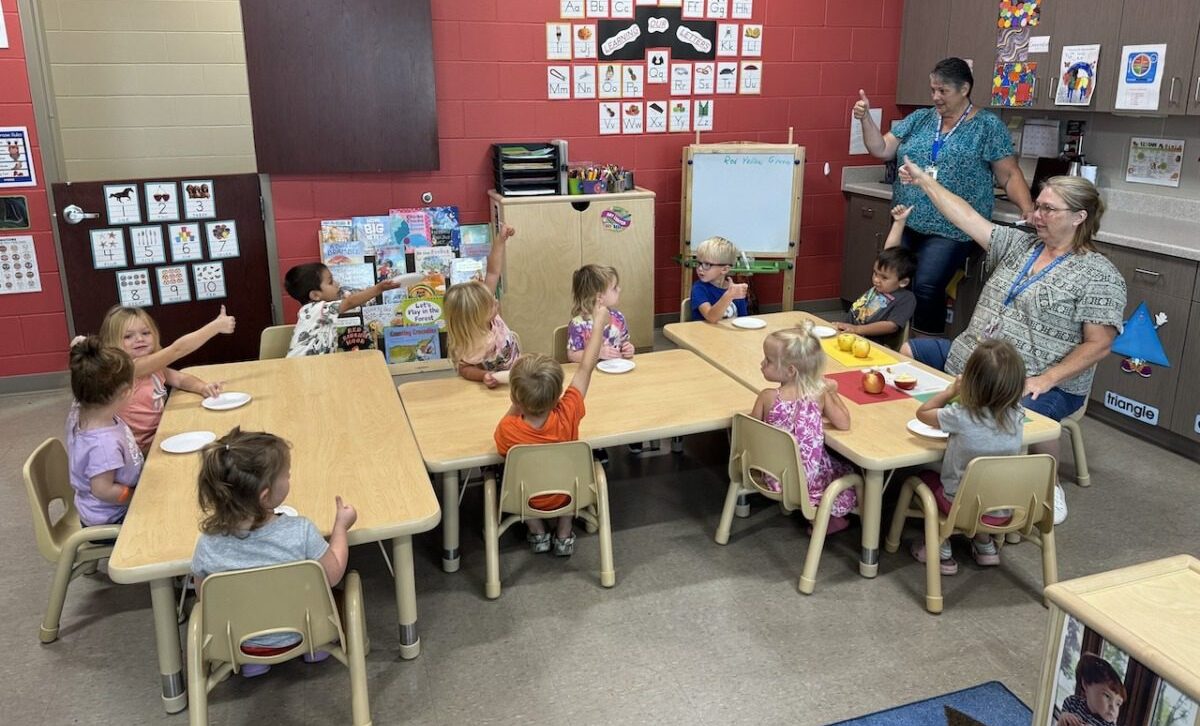
Child care providers say if they were able to operate at full capacity, they could serve up to 33,000 more kids. Photo by Salina Heller/UNN
The short answer to how Wisconsin daycares could serve 33,000 more kids? Hire more people to take care of those children. It’s a seemingly obvious answer to a problem that many family advocates in recent years have reached crisis level.
Almost 60% of child care providers across the state have unused capacity—closed classrooms—because of staff shortages due to things like low pay, lack of benefits, people deciding to stay at home with their own children, and a GOP-led legislature that’s not approving measures that would help working families. Providers report that if they were able to operate at full capacity, they could serve up to 33,000 more kids.
Even then, plenty of Wisconsin parents would still have to figure out child care: There are approximately 48,000 names on waitlists around the state.
Democratic Gov. Tony Evers released the figures as part of a Wisconsin Department of Children and Families (DCF) child care supply and demand survey.
“Working parents across our state depend on having high-quality, affordable child care so they can get to work and feed their families, but with providers closing their doors and reducing slots due to staffing, affordable child care is becoming harder and harder to find,” said Evers.
The industry isn’t sustainable, he continued. “If we want to address our state’s generational workforce challenges, we must make sure child care centers have the resources they need to keep their doors open, pay their staff fairly, and serve as many kids as possible.”
Renee Ernsting heads up the Child Care Partnership Program under Western Dairyland, a non-profit community action agency. She works with in-home and group child care centers in 10 counties in western Wisconsin and helps parents find care.
Ernsting said parents are paying more than $10,000 per child each year, but parent fees alone can’t fund high-quality child care. She said educators need higher wages and benefits.
“Centers can’t raise their rates any higher, parents can’t pay more, and we’re stuck with this problem of not being able to pay a wage a human can actually live on,” Ernsting said. “That’s the broken business model that we have going on in group centers.”
Due to thin margins, Wisconsin child care centers are only able to pay lead teachers an average of $13.55 per hour, which is less than half of the average hourly wage of $28.34 for all Wisconsin workers. As a result, early care and education professionals are leaving the field.
The problem is worse in rural areas, Ernsting said, where people aren’t starting in-home daycares at the levels they used to. She said significant state and federal funds are needed.
Evers’ 2023-25 budget proposal included making the Child Care Counts program permanent and state-funded, with a roughly $340 million investment to help keep Wisconsin workers in the labor force, expand access to affordable child care for working families, and support early care and education providers. Child Care Counts was initially created with temporary federal pandemic relief funds. Evers’ proposal for state funding along with many other budget investments to support working families were ultimately removed from the final state budget by Republicans in the Legislature.
Additionally, Evers has repeatedly called on the Legislature to pass his comprehensive workforce plan, made up of several different measures including some that would stabilize Wisconsin’s child care industry and keep doors open.
After months of Republicans delaying action on his requests, Evers directed $170 million in emergency stopgap funding to DCF to continue the Child Care Counts program at current funding levels through June 2025.
Kristin Elvaker runs the Blair-Taylor Childcare Center, in a rural child care desert between Trempealeau and Jackson Counties. She’s had a full roster since the center was built by the school district in 2021.
“The cost of care is high. And paying child care employees enough for that retainment piece, and then what you can charge parents—it just never adds up.” Elvaker said. “It’s never balanced out and parents are only making so much at their jobs, so every time you have to raise tuition to give staff a raise or snack prices go up—groceries go up—all that adds up.”
Elvaker said continually putting that cost onto parents won’t work. “I hope the state really keeps their eyes on child care and realizes how important it is and that Child Care Counts shouldn’t end, or some other form of funding starts going to childcare centers and helps support the important work education and birth-to-five really does—the brain development that happens in those early years.”
“I just hope the state can help us out and not end the funding.”
Support Our Cause
Thank you for taking the time to read our work. Before you go, we hope you'll consider supporting our values-driven journalism, which has always strived to make clear what's really at stake for Wisconsinites and our future.
Since day one, our goal here at UpNorthNews has always been to empower people across the state with fact-based news and information. We believe that when people are armed with knowledge about what's happening in their local, state, and federal governments—including who is working on their behalf and who is actively trying to block efforts aimed at improving the daily lives of Wisconsin families—they will be inspired to become civically engaged.


Uber or Park? How to answer the great travel debate in Wisconsin
When planning your next trip, it’s common to focus on three main expenses: airfare, hotels, and meals. However, there’s one often sneaky expense...

‘Some people work their butts off and other people get rich’: Gwen Frisbie-Fulton’s view from rural America
Growing up, my dad only made two rules for me outside of my chores. The first one was that I wasn’t allowed to make soap with lye. Glycerine soap,...

Trump’s inaugural speech is at odds with the Wisconsin economy. Could he trash the ongoing recovery?
The president says he’ll bring down inflation, which is already coming down, and build manufacturing, which is already on the rise in Wisconsin. His...

12 places in Milwaukee that offer student discounts
An estimated 70,000 college students go to school in Milwaukee, and most are unaware that their student ID can unlock special discounts and deals at...





